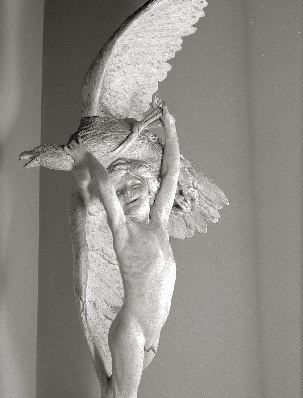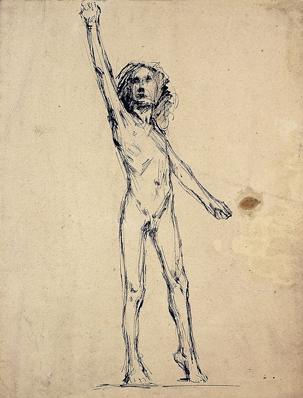The feathers
In 1885, at just 24 years old, Antoine Bourdelle found success with this work. At the time, he was a pupil of the sculptor Falguière in Paris. A significant feature of his work is its marked realism, seen in the chiselling of the bird’s feathers, along with its liveliness. The child is carried upwards in a huge vertical pull and also seems to be throwing himself forward, perhaps an allusion to the young artist himself, setting out into the world?
The sources
Bourdelle drew his inspiration from Gustave Flaubert’s novel Salammbô: "The creature, in its fury, enveloped him with the beating of its wings; he crushed it against his breast, and his laughter, haughty and ringing as the clash of swords, grew louder as its struggles ceased."
Some of these elements can be found in the sculpture, such as the smile and the powerful beating of the wings, although Bourdelle has preferred a stretching movement of the figure rather than a crushing embrace.
The feet
Hannibal seems about to leave the ground, carried upwards by the power of the bird, a frail child in this fight from which he will emerge victorious.
Plaster or bronze?
Two works are presented side by side in the room. One is the original plaster, presented at the 1885 Salon and immediately purchased by Countess de Mari, a patron of Bourdelle, to give to the Musée de Montauban; and the other is the bronze version that was cast from it.
To be able to admire the two works together is rare, and gives us a clearer understanding of the stages involved in the production of a bronze.

Emile-Antoine Bourdelle, La Première victoire d’Hannibal [Hannibal's first victory], 1885. Plaster. MI.885.12.1. © Ville de Montauban-Musée Ingres Bourdelle. Photographer: Guy Roumagnac.
The work illustrates an episode from the childhood of the future Carthaginian General Hannibal, famous for having attacked Rome after crossing the Alps with his war elephants.
While a very young child, he captured an adult eagle. This episode reminded Bourdelle of a scene from his youth, when an eagle found itself trapped in his aunt’s home.

Emile-Antoine Bourdelle, Etude pour La Première victoire d’Hannibal [Sketch for Hannibal's first victory], 1885. Quill and blank ink on paper. MI.5.8.22. © Ville de Montauban-Musée Ingres Bourdelle. Photographer: Marc Jeanneteau.
A modern casting
This bronze is a recent casting (or "proof"). Starting from the plaster exhibited opposite, a bronze casting was produced in 1992. And so, on the base, Bourdelle's signature on the left-hand side finds itself co-existing with the stamp of the founder, Coubertin, and with a resolutely modern inscription "by Bourdelle No. 2". In fact, bronze casts are numbered, thereby ensuring they are unique.